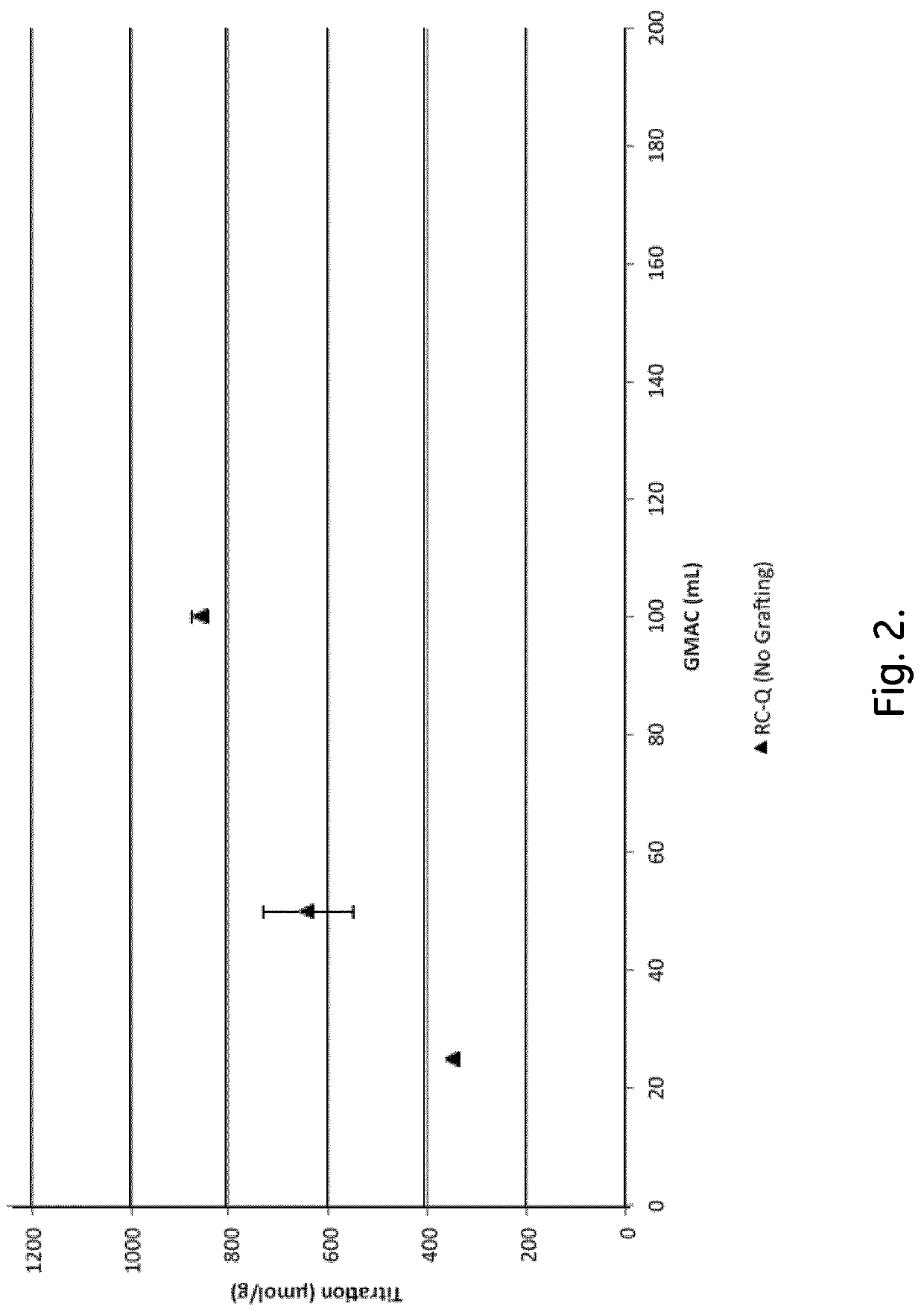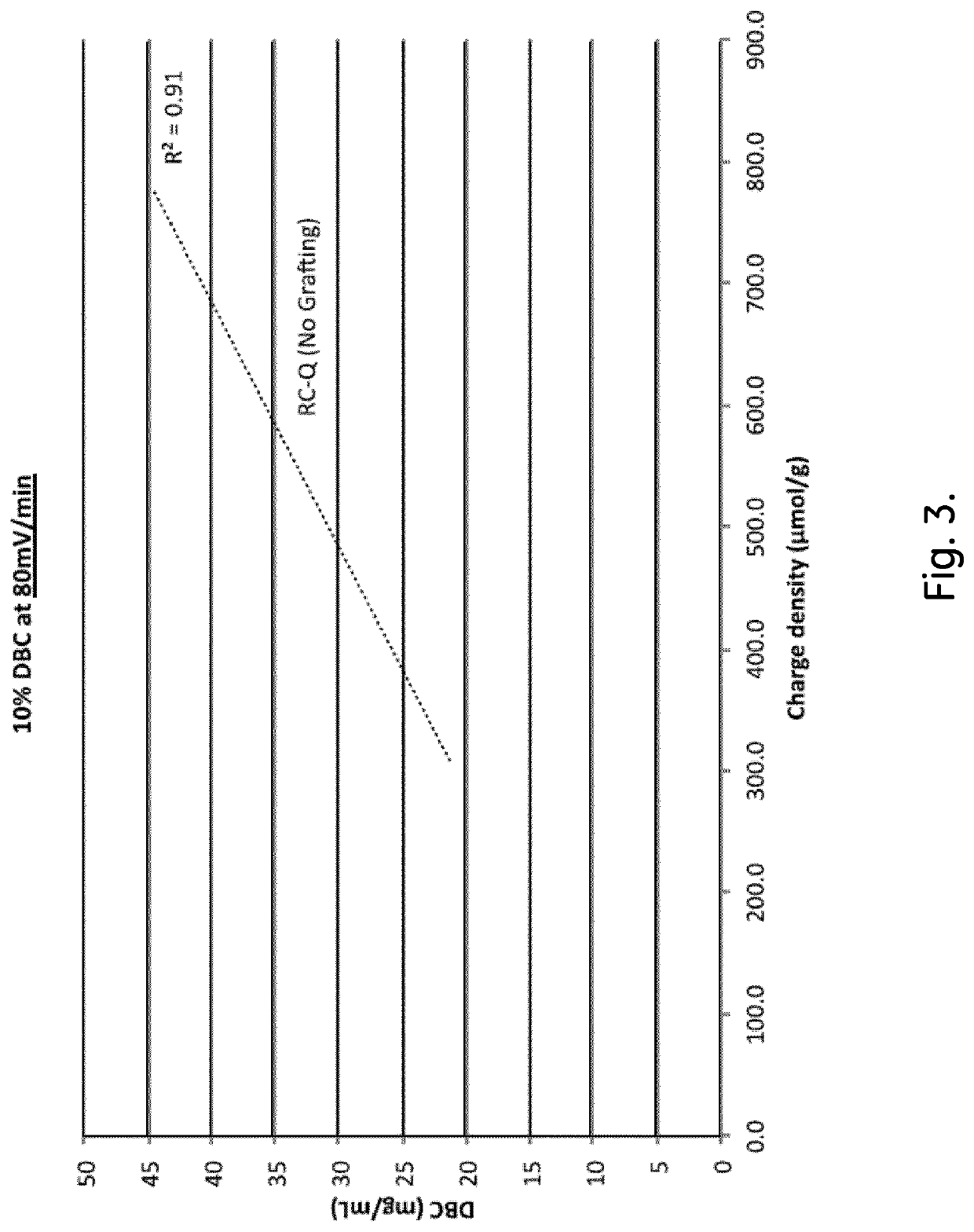Chromatography Media and Methods for Producing Them
a chromatography media and chromatography technology, applied in the direction of cation exchanger materials, other chemical processes, separation processes, etc., can solve the problems of uncontrollable degree of control, inability to address the control of material capacity and increase, and detrimental to the productivity of chromatography materials, etc., to achieve improved properties, higher capacity, and improved productivity
- Summary
- Abstract
- Description
- Claims
- Application Information
AI Technical Summary
Benefits of technology
Problems solved by technology
Method used
Image
Examples
example 1
Trimethylammonium Chloride Functionalisation
[0221]Nanofibre materials were derivatised according the scheme outlined below:
Step (i): Saponification of Cellulose Acetate (CA) to Regenerated Cellulose (RC)
[0222]
[0223]Cellulose acetate sheets (0.44*32 mm*150 mm) obtained in accordance with the method of Preparative Example 1 were placed into a large beaker containing 5 L of a 0.075 M sodium hydroxide solution in 2:1-water:ethanol. The reaction mixture was stirred at room temperature for 48 hours. The materials were then washed according to washing protocol A.
Step (ii): Glycidol Polymerisation
[0224]
[0225]Materials from (i) were suspended in 1 L of 0.5 M NaOH. The reaction media was circulated for 15 minutes prior to the careful addition of varying amounts of glycidol (15 mL, 30 mL, 60 mL, 120 mL, 180 mL) in a single portion. The reaction media was circulated at room temperature for 16 hours and the material was subsequently washed according to washing protocol B.
Step (iii): Glycidyltrim...
example 2
S Functionalisation
[0227]Nanofibre materials were derivatised according to the scheme outlined below:
Step (i): Saponification of Cellulose Acetate (CA) to Regenerated Cellulose (RC)
[0228]
[0229]Cellulose acetate sheets (0.44*32 mm*150 mm) obtained in accordance with the method of Preparative Example 1 were suspended in 5 L of a 0.075M sodium hydroxide solution in 2:1-water:ethanol. The reaction mixture was circulated at room temperature for 48 hours. The materials were then washed according to washing protocol A.
Step (ii): Glycidol Derivatisation
[0230]
[0231]Materials from (i) were suspended in 1 L of 0.5M NaOH. The reaction media was circulated for 15 minutes prior to the careful addition of varying amounts of glycidol (15 mL, 30 mL, 120 mL, 180 mL) in a single portion. The reaction media was circulated at room temperature for 16 hours and the material was subsequently washed according to washing protocol B.
Step (iii): 1,4-Butanesulfone Derivatisation
[0232]Reaction media consisting o...
example 3
Carboxymethyl (CM) Functionalisation
[0234]Nanofibre materials were derivatised according the scheme outlined below:
Step (i): Saponification of Cellulose Acetate (CA) to Regenerated Cellulose (RC)
[0235]
[0236]Cellulose acetate sheets (0.44*32 mm*150 mm) obtained in accordance with the method of Preparative Example 1 were placed into a large beaker containing 5 L of a 0.075 M sodium hydroxide solution in 2:1-water:ethanol. The reaction mixture was stirred at room temperature for 48 hours. The materials were then washed according to washing protocol A.
Step (ii): Glycidol Polymerisation
[0237]
[0238]Materials from (i) were suspended in 1 L of 0.5M NaOH. The reaction media was circulated for 15 minutes prior to the careful addition of varying amounts of glycidol (15 mL, 30 mL, 60 mL, 120 mL, 180 mL) in a single portion. The reaction media was circulated at room temperature for 16 hours and the material was subsequently washed according to washing protocol B.
Step (iii): Carboxymethyl (CM) De...
PUM
| Property | Measurement | Unit |
|---|---|---|
| diameters | aaaaa | aaaaa |
| diameters | aaaaa | aaaaa |
| diameters | aaaaa | aaaaa |
Abstract
Description
Claims
Application Information
 Login to View More
Login to View More - R&D
- Intellectual Property
- Life Sciences
- Materials
- Tech Scout
- Unparalleled Data Quality
- Higher Quality Content
- 60% Fewer Hallucinations
Browse by: Latest US Patents, China's latest patents, Technical Efficacy Thesaurus, Application Domain, Technology Topic, Popular Technical Reports.
© 2025 PatSnap. All rights reserved.Legal|Privacy policy|Modern Slavery Act Transparency Statement|Sitemap|About US| Contact US: help@patsnap.com



